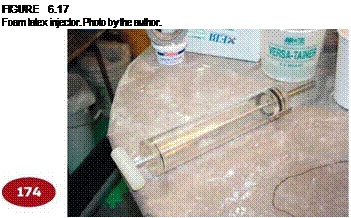There are really only two ways to get foam latex into the mold: pouring it in or injecting it into the negative mold. For molds that are no larger than a face, pouring works very well.
If there are deep areas in the mold, such as a long nose for the character of Cyrano de Bergerac (think of Steve Martin’s character in the movie Roxanne), you might first want to spoon or use a spatula to get some foam down into the nose tip to ensure that it fills and doesn’t create an air pocket before you pour or spoon in the rest of the foam. You will learn over time

![]()
how much or how little foam you actually need to place in the mold to fill it; when you press the positive into the negative, the foam will spread out and into other areas of the mold. If there are deeper portions the foam needs to reach, you will want to use a spatula, craft stick, or even your hand (in a rubber glove!) to spread it into those areas to avoid trapping air.
As the foam is pressed outward by the positive, the excess needs to have somewhere to go; that is why you created an area for flashing, or runoff, when you made the mold. It might even be worthwhile to have drilled small escape holes, called bleeders, in the positive to help facilitate the escape of excess foam latex. Foam latex has a lot of resistance to compression, and for your appliance to have fine, ultra-thin edges, both halves of the mold must be able to close completely and touch at the mold’s cutting edge.
It is often necessary to inject the foam latex into a mold—say, for a full head cowl piece or a large three-piece mold (one inner core positive and two front and back negatives) that would be difficult or very messy to hand-pour.
Large foam injection syringes are available for sale from several sources listed in the appendix. When foam is injected, it is fundamentally different than when you pour the foam onto an open mold. The mold is tightly closed, making it almost airtight, and the act of injecting foam into the mold will create pressure in the mold; air in the mold will need to escape. Without numerous small bleeder holes drilled or bleeder channels etched into the mold positive, foam will not be able to flow easily into those areas.
